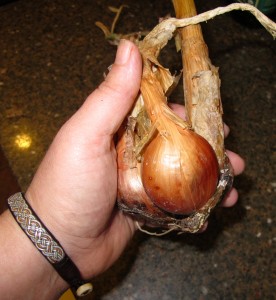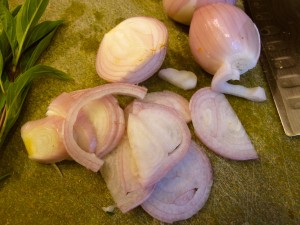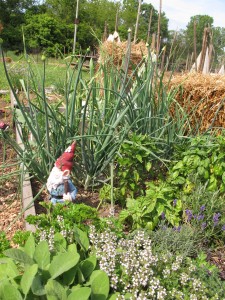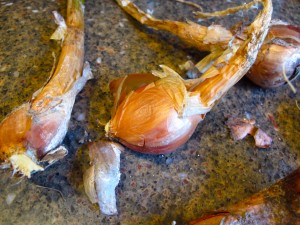The Lady of Shallots
 That’s me, though I didn’t get a poem written about me over it. But then I wasn’t cursed to only look at the world through a mirror and constantly weave what I see in some magic tapestry either.
That’s me, though I didn’t get a poem written about me over it. But then I wasn’t cursed to only look at the world through a mirror and constantly weave what I see in some magic tapestry either.
I just grew shallots.
Lovely, delicious shallots.
Which, I am happy to report are even easier to grow than garlic which is easier to grow than onions, especially if you grow them from bulbs rather than seed. (Though in the years to come, I’m going to attempt to grow them from seed, too.)
Some people eschew shallots, swearing that people cannot tell the difference between their flavor and that of onions, but I disagree. Especially in Thai recipes, such as Thai Basil Chicken the flavor of shallots is necessary, for they are milder than onions with a lingering sweetness that really brings a depth to the sauce that is lacking from onions. (Though, I have found that if you are going to substitute onions for shallots, try using smaller younger onions–they have a bit more sugar in them and not as much of the sulfurous scent that gives onions their characteristic bite.)
Without shallots, the above recipe, which is Zak’s favorite dish of all time, I think, the dish lacks depth. The sugar in the shallots that caramelizes so quickly in the wok really is magical. And last night, when I made it for the first time with my own shallots, I found that freshly harvested shallots are even sweeter and more delectable than the ones found in the store.
Only one farm family that I know of grows shallots around here commercially (That would be Kim and Larry of Cowdery Farm), and they don’t have them very often, so I decided last fall to give shallots a try. I figured since I hate using the ones from the grocery store from who knows where grown who knows how, and I do have a community garden plot, it should be no trouble for me to experiment with a pound of shallot bulbs.
Territorial Seed Company carries shallot bulbs and seeds both, and they have an admirable selection of both. This year, I grew Sante shallots; next year I am growing them as well as some Dutch Yellow and Gray shallots.
They really are easy to grow.
In the fall, you plant shallots (round end down and pointed end up!) in soil rich in organic matter about six inches apart with the pointed end either at soil level or only slightly below. They are shallow rooted. Water them well, and then mulch well with straw or other organic matter. If the winter is mild, you might see some green sprouts unfurling about February, but they really look like they’re never going to grow until suddenly springy leaf-green shoots start popping up reliably where you planted them. It doesn’t take them long to really start growing like mad, so long as you keep them moderately moist (don’t over-water or under-water) and feed them now and again with some side dressings of compost, manure, worm castings or fish emulsion.
No pests bother shallots. Deer don’t think they’re tasty. Bugs don’t like them. slugs hate them. They can get a bit overly wet and catch a fungus or mold in the bulbs–in that case, if it’s raining too much, pull back the mulch to let the water evaporate a bit. If it isn’t raining enough, like this year, you’ll be happy for the mulch. (I used wheat straw. But chopped up fallen leaves are great, too, or grass clippings or what have you.)
They grow pretty fast to about three feet, and they set pretty white globular blossoms. (You can see in the picture here my shallots with their guardian gnome standing watch.) You harvest them when the tops start dying back, which happened here in July, though I am led to believe that this was early for them. You just pull them up and cut off the stalks about four inches up from the bulbs, and then set them in a dry, cool, airy place to dry out for a week or so.
You’ll find that they grow in clumps, with each bulb you planted having at least two, but most often three to five bulbs growing along side it, sometimes attached to it, and sometimes not. If they are attached, pry them apart, and dust off as much dirt as possible before setting them to dry.
And that’s it. That’s how to grow shallots.
Now, what do you do with them? Well, I suggest you try my Thai Basil Chicken recipe above, but shallots are great in other recipes, too. They classically used in vinaigrette and Bearnaise sauce in French cookery and I think they taste just stunning in a stir fry.
They’re good roasted and eaten just by themselves, too.
So, there we are–I’m a Lady of Shallots, and now, you can be one too.
Unless you’re a guy. Then, you get to be Lord of Shallots.
Now if I can just get someone to write a poem about me….
1 Comment
RSS feed for comments on this post.
Sorry, the comment form is closed at this time.
Powered by WordPress. Graphics by Zak Kramer.
Design update by Daniel Trout.
Entries and comments feeds.



Yet another thing I’m going to have to try when I get a real yard with space for a real garden (as opposed to the container garden I currently have on my deck).
Comment by Laura B. — July 10, 2012 #